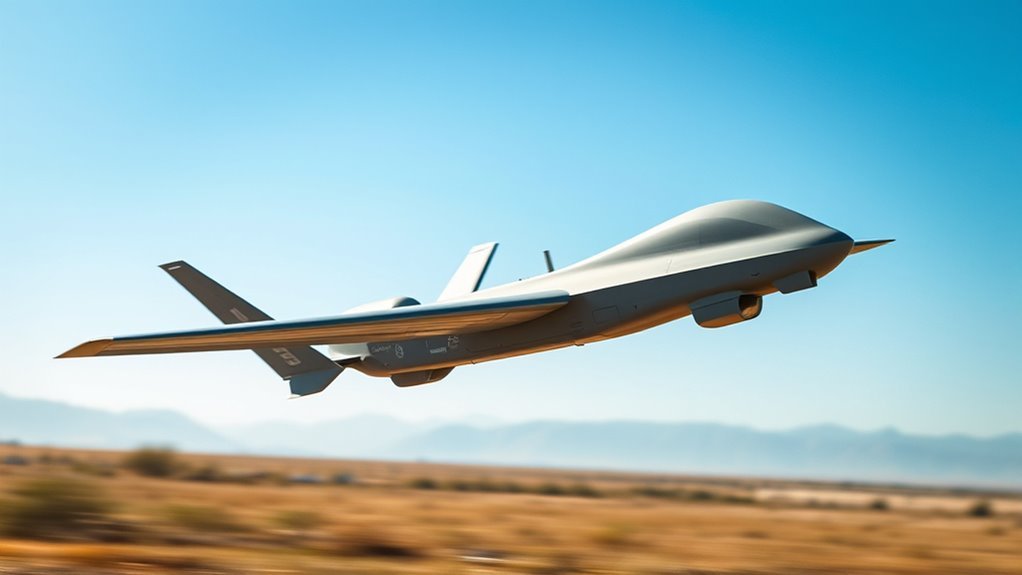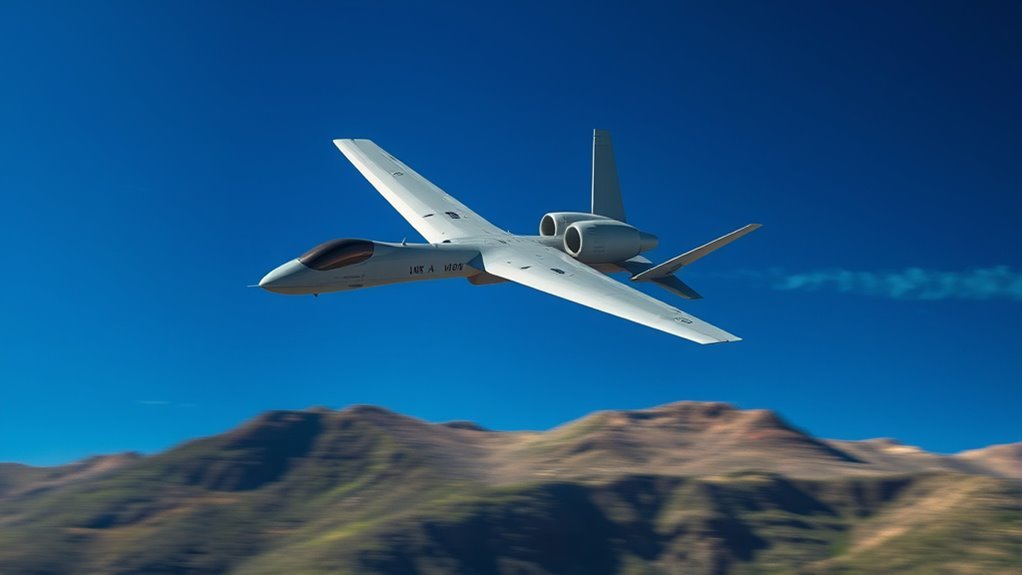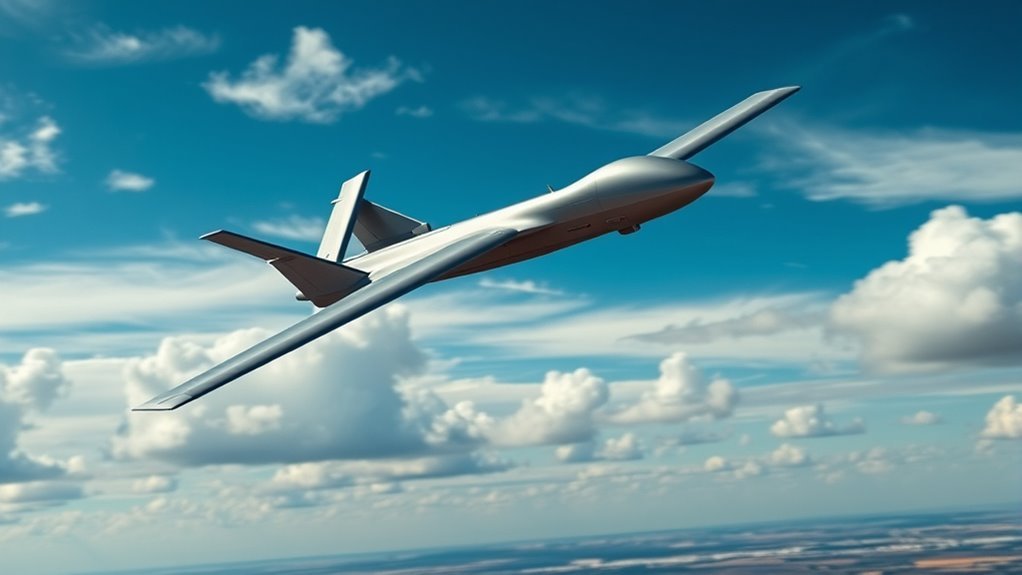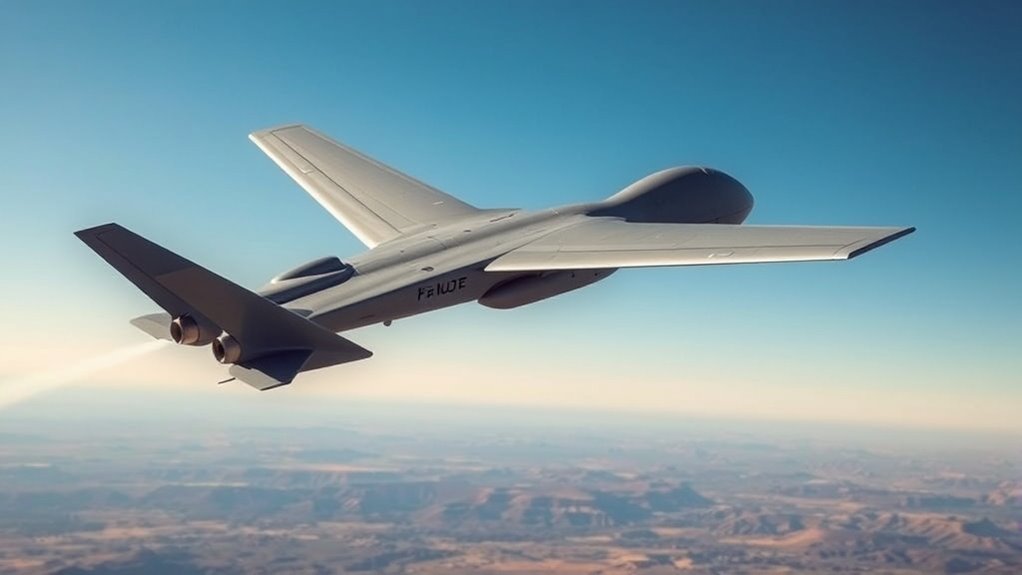Military drones can reach impressive maximum speeds of up to 400 mph, especially in advanced models like the X-47B and Global Hawk. These high speeds are achieved through cutting-edge engineering and aerodynamic design, allowing for stealthy operations. While traditional aircraft can exceed 1,500 mph, drones excel in agility and mission-specific capabilities. Their speed, combined with advanced technologies, redefines their role in modern warfare. Explore further to uncover how these advancements impact military strategy.
Overview of Military Drones

Military drones, often referred to as Unmanned Aerial Vehicles (UAVs), have revolutionized modern warfare and surveillance operations. You’ll find that their capabilities extend beyond simple reconnaissance; they offer real-time data collection, precision targeting, and even logistical support. These drones are essential to military applications, providing a tactical advantage while minimizing risk to personnel. With features like advanced sensors and high-resolution cameras, they gather intelligence in hostile environments, ensuring informed decision-making. Furthermore, their ability to operate in diverse terrains expands operational reach. As you explore the impact of military drones, it’s clear they’ve transformed strategic planning and execution, embodying both technological advancements and the pursuit of freedom in conflict scenarios. Understanding these dynamics is vital for grasping modern military strategies.
Types of Military Drones

While exploring the various types of military drones, you’ll find that they can be categorized based on their specific functions and operational roles. The primary categories include combat drones, designed for direct engagement, and reconnaissance drones, tailored for intelligence gathering. Combat reconnaissance drones excel in providing real-time data during missions, enhancing situational awareness for ground forces. In contrast, surveillance drones focus on long-duration monitoring, capable of conducting extensive surveillance operations over vast areas, thereby facilitating strategic decision-making. Each type serves an essential role in modern warfare, ensuring that military forces can adapt to evolving threats. Understanding these distinctions is important for appreciating how drones contribute to operational effectiveness and the pursuit of freedom in conflict zones.
Factors Influencing Drone Speeds

When evaluating drone speeds, several key factors come into play. The design and engineering of the drone, along with its payload capacity limits, greatly influence performance. Additionally, environmental conditions, such as wind and temperature, can further impact speed capabilities.
Design and Engineering
The design and engineering of drones greatly influence their operational speeds, as various factors interact to optimize performance. Key elements include drone aerodynamics, which determines how efficiently air flows over the surface, and stealth technology, which minimizes radar detection while maintaining speed.
| Factor | Description | Impact on Speed |
|---|---|---|
| Aerodynamics | Shape and surface design | Reduces drag |
| Engine Design | Type and power of propulsion | Increases thrust |
| Materials | Weight and durability of components | Affects maneuverability |
| Wing Configuration | Shape and size of wings | Influences lift |
| Stealth Features | Coating and design to avoid detection | May limit speed |
Understanding these interactions allows for advancements in military drone capabilities, enabling faster and more efficient operations.
Payload Capacity Limits
Payload capacity limits greatly impact drone speeds, as heavier loads can hinder acceleration and maneuverability. When you consider the payload weight, it’s essential to balance the mission’s requirements with the drone’s performance capabilities. A drone designed for high-speed operations may struggle to maintain its velocity when loaded beyond its ideal payload capacity. This not only affects speed but also operational efficiency; the heavier the payload, the more power is required to achieve desired flight parameters. Consequently, operators must evaluate the trade-offs between the payload and speed, ensuring that the drone can effectively perform its tasks without sacrificing performance. By understanding these limits, you can enhance your drone’s capabilities and maximize its effectiveness in the field.
Environmental Conditions Impact
Although numerous factors influence drone speeds, environmental conditions play a critical role in determining operational efficiency. Weather effects, such as wind speed and direction, directly impact a drone’s ability to maintain its maximum velocity. Headwinds can greatly slow down your drone, while tailwinds can enhance its speed, altering performance dynamics. In addition, altitude variations also come into play; as you ascend, air density decreases, which can affect lift and propulsion. Operating at higher altitudes might allow greater speeds in some circumstances but could also lead to reduced engine performance. Awareness of these environmental factors is essential for optimizing drone operations, ensuring you adapt strategies to maximize speed and efficiency in varied conditions.
Notable Fast Military Drones
While advancements in military drone technology have led to increased operational capabilities, speed remains an essential factor in their effectiveness. Notable fast military drones utilize cutting-edge stealth technology for reconnaissance missions, ensuring they can gather intelligence while remaining undetected. Below, you’ll find a comparison of some of the fastest military drones.
| Drone Model | Max Speed (mph) |
|---|---|
| MQ-9 Reaper | 300 |
| RQ-170 Sentinel | 300 |
| X-47B | 400 |
| Global Hawk | 400 |
These drones demonstrate the balance of speed and stealth, allowing military forces to execute critical tasks efficiently while minimizing risks. As technology evolves, expect even faster models to emerge, enhancing operational freedom.
Speed Comparisons With Traditional Aircraft
When comparing the speeds of military drones to traditional aircraft, it’s crucial to take into account not just the maximum velocities but also the operational contexts in which these vehicles are deployed. Drones often excel in drone agility, allowing them to navigate tight spaces and execute rapid maneuvers. In contrast, traditional aircraft, while generally faster, may lack the same level of aircraft maneuverability in complex environments. For instance, while a fighter jet might reach speeds over 1,500 mph, its operational effectiveness could diminish in urban settings. Drones, with their lower speeds, can maintain precision and adaptability, making them invaluable for reconnaissance and targeted operations. Ultimately, speed isn’t the sole measure of effectiveness; operational capability matters greatly.
Technological Innovations in Drone Design
As advancements in technology continue to reshape military capabilities, innovations in drone design play a pivotal role in enhancing operational effectiveness. By integrating advanced drone materials, manufacturers are creating lighter, more durable platforms that can withstand harsh conditions while maximizing speed. The use of composite materials reduces weight without compromising structural integrity, allowing for longer missions and higher payloads. Additionally, aerodynamic shapes are meticulously engineered to minimize drag and optimize flight performance. This focus on streamlining designs not only boosts speed but also improves maneuverability and stealth capabilities. Moreover, the integration of advanced obstacle avoidance systems enables military drones to navigate complex environments with enhanced safety. Together, these innovations enable military drones to operate at unprecedented velocities, providing you with enhanced tactical advantages in diverse environments. Ultimately, these advancements reflect a commitment to maintaining freedom and superiority in aerial operations. Moreover, the aerodynamic design is crucial in enhancing stability and reducing air resistance, further contributing to improved flight performance.
Implications of High-Speed Drones in Warfare
The rapid advancements in drone technology have ushered in a new era of warfare, where high-speed drones redefine strategic dynamics on the battlefield. These drones provide significant tactical advantages, but they also introduce complex strategic challenges that must be addressed.
- Enhanced reconnaissance capabilities that outpace traditional methods
- Increased difficulty in enemy interception and countermeasures
- Evolving rules of engagement and ethical considerations
As you analyze these implications, consider how high-speed drones can shift the balance of power. While they allow for rapid response and precision strikes, they also complicate international norms and escalation protocols. The dual-edged nature of high-speed drones underscores the need for new strategies in warfare to maximize their potential while mitigating associated risks.
Future Trends in Military Drone Development
As military drone technology advances, you’re likely to see significant improvements in propulsion systems that enhance speed and efficiency. Additionally, the integration of autonomous flight capabilities will enable drones to operate with greater precision and reduced human intervention. These trends will fundamentally reshape tactical operations and redefine the role of drones in modern warfare.
Enhanced Propulsion Technologies
While advancements in drone technology continue to reshape military operations, enhanced propulsion technologies stand out as a critical factor driving future developments. These propulsion advancements focus on speed optimization and efficiency, greatly impacting drone performance.
- Electric propulsion systems: Offering quieter operations and reduced thermal signatures.
- Hybrid engines: Combining fuel and electric power for extended range and versatility.
- Advanced materials: Lightweight composites that improve thrust-to-weight ratios.
Autonomous Flight Capabilities
Advancements in propulsion technologies not only enhance speed but also pave the way for significant developments in autonomous flight capabilities. With improved autonomous navigation systems and sophisticated flight algorithms, military drones can perform complex missions with minimal human input. This shift toward autonomy provides enhanced operational efficiency and reduces risks to personnel.
| Feature | Description |
|---|---|
| Autonomous Navigation | Ability to navigate without human input |
| Flight Algorithms | Algorithms that optimize flight paths |
| Real-time Decision-Making | Instant responses to changing environments |
| Mission Adaptability | Capability to adjust to mission parameters dynamically |
As these technologies evolve, you’ll see drones capable of executing missions in contested environments, maximizing their effectiveness while maintaining the freedom of operation.
Conclusion on Speed and Military Strategy
Given the rapid evolution of military drone technology, speed has become a pivotal element in modern warfare strategy. Fast drones offer distinct strategic advantages in drone warfare, enhancing operational effectiveness.
Speed is now a crucial factor in military drone strategy, providing strategic advantages that enhance operational effectiveness in modern warfare.
- Surveillance Efficiency: Quick deployment allows for timely intelligence gathering.
- Target Engagement: High-speed capabilities enable swift strikes, limiting enemy response time.
- Tactical Flexibility: Rapid repositioning supports dynamic mission adjustments.
Incorporating speed into military strategy isn’t just about having faster drones; it’s about leveraging that speed to outmaneuver adversaries. As you consider the future of warfare, understanding how speed integrates with technology and tactics will be essential for maximizing your operational success. Embracing these advancements can empower you to achieve superior outcomes on the battlefield. Furthermore, the integration of AI-driven autonomy ensures that drones not only fly fast but also make real-time decisions to enhance mission effectiveness.
Frequently Asked Questions
What Are the Fastest Military Drones in Operational Service Today?
You’ll find that the fastest military drones today utilize advanced stealth technology and cutting-edge drone innovation. These systems enhance operational efficiency and tactical advantage, reflecting a commitment to maintaining superiority in modern warfare and security.
How Do Military Drones Compare to Commercial Drones in Speed?
When you compare military and commercial drones, you’ll find military drones often exceed commercial models in speed due to advanced drone technology. However, both types face inherent speed limitations based on design and operational requirements.
What Is the Role of Speed in Drone Combat Effectiveness?
Speed advantages in drone combat enhance tactical maneuvers, allowing you to outmaneuver opponents and respond swiftly to threats. It’s essential for effective reconnaissance, strike capabilities, and overall mission success, giving you a significant edge in dynamic environments.
Can Military Drones Exceed the Speed of Sound?
You’ll find that while most military drones lack supersonic capabilities, advancements in drone technology are pushing boundaries. Some prototypes aim for speeds exceeding sound, but practical deployment remains complex and generally untested in active scenarios.
How Do Environmental Conditions Affect Drone Speed Capabilities?
Environmental conditions greatly impact drone speed. Wind resistance can slow you down, while altitude effects alter air density, affecting propulsion. Understanding these factors helps you optimize performance, ensuring your drone navigates efficiently in various settings.

